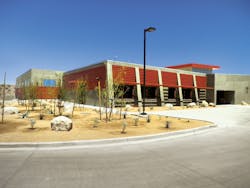About the author: Elisabeth Lisican is managing editor of Water & Wastes Digest. Lisican can be reached at [email protected] or 847.391.1012.
Nestled in the Mojave Desert, the city of Henderson, Nev., is part of the Las Vegas metropolitan area, which spans the entire Las Vegas Valley. It has a population of more than 257,000 and occupies the southeastern end of the valley. It is known as an affluent city and has been ranked as one of the safest cities in the U.S.
The city also is home to the Southwest Water Reclamation Facility (SWRF), which completed construction and started treating wastewater on Dec. 7, 2012. The SWRF currently receives 4 million gal per day (mgd) from about 90,000 area homes. The sewershed upstream of the plant has a lot of room for development, so plant flows should increase as the area is populated.
Demand & Response
In 1999, the city recognized the need for a satellite facility to support increasing wastewater treatment and reclaimed water distribution demands in southwest Henderson. Construction on the 20-acre site started in March 2008. The project cost totaled more than $94.4 million.
“The facility is an 8-mgd-capacity satellite plant that skims sewage from the collection system on the southwest side of Henderson and treats it to reclaimed water standards for use on area golf courses,” said Adrian Edwards, water & wastewater operations manager for the city of Henderson. “Before the SWRF, wastewater in Henderson was conveyed to the Kurt R. Segler Water Reclamation Facility on the east side of town.”
By treating water on the higher side of town, the city no longer has to pump reclaimed water through 11 miles of piping, through two pump stations, and upward more than 600 ft in elevation. This creates a significant ongoing operational cost savings.
The city reclaims more than 8,300 acre-ft per year of highly treated effluent as irrigation for area golf courses, median strips, a cemetery and a bird viewing preserve. It also may be used in dust control for construction.
“The SWRF is a membrane biological reactor plant, using a combination of activated sludge wastewater treatment combined with membrane technology,” Edwards said. “The activated sludge process treats the wastewater and the membrane separates the treated water from the sludge. The hollow tube membranes allow for a smaller plant footprint and the minimization of treatment chemicals stored on site. The SWRF uses biofilters and granular-activated carbon to treat gases and absorb odors.”
Permits in Southern Nevada share a waste load allocation for phosphorus and ammonia. Due to the warmer weather, nitrification of ammonia is readily achieved. Phosphorus limits average 0.17 mg/L and are met through a combination of biological nutrient removal built into the activated sludge and ferric chloride addition in the anaerobic zones.
SCADA Software
The SWRF was designed and built with a control system new to the city. The Wonderware SCADA software allows for plant control from either of the city’s two treatment plants.
Several training sessions right before the plant’s opening taught the operators how to use the new system, which is faster and more user friendly than the old system.
“Trending capabilities greatly assist the operators in troubleshooting and monitoring plant processes,” Edwards said. “In-house SCADA programming and support has proven invaluable.”
Treatment Challenges
The relatively “fresh” sewage coming into the SWRF creates challenges for the operators striving to use biological nutrient removal. The sewage is low in volatile fatty acids, making the biological removal of phosphorus more difficult.
“Operations is attempting to optimize the process by manipulating grit basin detention times, step feed splits and recycle flows,” Edwards said. “Hopefully the right mixture of those parameters will prevent the need for costly chemical addition.”
Membrane technology is new to the city of Henderson.
“Operators have been adapting to the new equipment very well, utilizing an organized approach through a computerized maintenance management system for the scheduling and tracking of preventive maintenance work orders,” Edwards said. “They also have found great benefit in networking with other membrane plant operators and attending manufacturer-sponsored conferences.”
Download: Here
